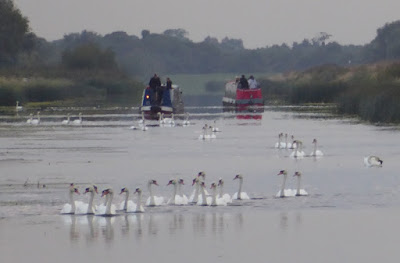… and it did NOT hold. But I'll start at the beginning of this exciting day.
My alarm went off at 0459 so I would be sure of a 0600 getaway. This was the time suggested by others in our little convoy; I had wanted a later start so we would meet the tide further up the river, but I went along with the prevailing opinion. It later transpired that the later start might have been better, but that's water under the bridge (literally).
At 0620 we passed under the road bridge marking the start of the New Bedford River or One Hundred Foot Drain.
There were six boats in our convoy: two in front ...
and three behind.
Everything was going well. I had cranked up our revs to about 1400 rpm (300 more than our usual cruising speed) and we were making about 5 mph.
Until, that is, we entered a narrow section.
Our speed reduced and the boats were churning up the mud. The engine must have been labouring because the over-temperature alarm went off. We reduced speed and opened the hot taps to drain off some of the heat. After a couple of minutes the alarm stopped and we gingerly increased speed again. This happened two or three times.
Around the same time we met the incoming tide, bringing with it lots of weed.
Our speed dropped even more until we stopped making any forward progress.
When we started going backwards we struggled against the tide for five minutes before I decided it would be sensible to drop the anchor so we would stop going backwards. We could also cut the engine and let it cool down.
So I lowered the anchor over the side and into the water. This was the first time it would be tested. As soon as the anchor touched the bottom it pulled hard on the chain and the warp (the nylon rope) connected to it. I was not expecting the force of the pull; consequently the warp tangled and formed a knot shortening it by a few feet. The end was (of course) already attached to the T stud on the boat, and everything immediately went taut.
What really surprised me was the realisation that the anchor - a really heavy one - was dragging along the bottom. Who knew? I thought the whole point of an anchor was to secure the boat in an emergency, but this was not working. It did, at least, considerably slow our backward progress, so we switched off the engine and suggested to Bob on Bimble, who was also going backwards, that he tie up to us. This he did, and he dropped his own anchor.
We were still going backwards but after a while we stopped moving. The anchors must have just been sliding along the mud until the flow lessened. I estimate the flow was about 6 mph at its peak.
I made coffee and had a look down the weed hatch. There was a considerable amount of weed round the prop and the top of the rudder.
After about 45 minutes we thought we should try to get going again, so I pulled Bob, who was single handing, forward on his centre line so he could weigh his anchor. Then he was off.
We motored forward and I pulled up our anchor. It came up easily, which was a relief. Then we got under way and were surprised that we were very soon able to make 5 mph at about 1200 rpm. The tide had evidently turned quickly. I phoned the lock keeper at Salter's Lode again when we were approaching Denver (we had phoned him when we were stuck). We had seen Bimble ahead of us reverse onto the pontoon by Denver Lock; Paul at Salters Lode said we could come straight to his lock. So we kept going and turned into the lock entrance as a boat in front was just going into the lock.
I won't go into details about any perceived queue jumping. We continued on the Middle Level to March, where, at gone 1830, we tied up against a friendly hire boat.
The end of a long, interesting day! Oh yes, if we'd left Earith later we would have met the tide when it had come further along the drain. Then it would have had less effect and we might have been able to push against it.
Some final stats
-
After a long cruise I normally do a post with some stats for the trip, so I
thought it would be nice to do some stats for the whole of our ownership of
B...
5 days ago
































2 comments:
It appears,from the photos, that your anchor is only fastened to the boat by the front T-Stud. One cause of anchor failure is the weld on the T-Stud breaking with the jerk as the anchor pulls tight.
It is better if the anchor is also fastened to a second location with the rope passed around the T-Stud on the way into the water, or passed around the second location if it starts at the T-stud.
Paul, the anchor mounting didn't fail and there was no sudden jerk in this instance. The anchor didn't work as I thought it should because, presumably, there was too much mud down there for it to find anything solid to grip on. It's a good point about the second mounting point; I'm not sure where it would go, though.
Post a Comment